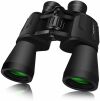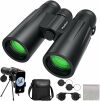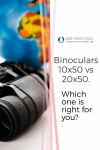
INTRODUCTION
Binoculars are some of the most frequently used optical instruments. These devices are handheld and are designed to provide a magnified and enhanced view of distant objects. Essentially, a pair of binoculars is two small telescopes mounted on a single frame. Good binoculars are carefully aligned with lenses that reduce glare.
You may experience some confusion when shopping for binoculars. Binoculars vary in both physical aspects; size, type, features and optical performance.
PRO-TIP
If you're looking to invest in binoculars, it is worth doing research on the optical, physical, and price differences between each option!
WHAT IS MAGNIFICATION POWER AND OBJECTIVE LENS
One of the easiest ways to figure out the differences between binoculars is their description. For instance, you may find 10x42, 10x50, and 12x50 binoculars. The first number in each of them the magnification power of the optical instruments.
A 10x42 and 10x50 device will bring images 10 times closer than when viewing them with the human eye whereas, the 12x50 will bring it 12 times closer. It is safe to assume that a higher number will result in better images. However, that is not necessarily the case.
Higher magnification makes it more difficult for users to hold images steady in view. Therefore, a higher magnification is only recommended if you are stationary and viewing small objects at a great distance. But if you intend to use your binoculars while moving around with quick focus, use devices with lower magnification power.
The second number represents the size of the lens. Both 10x50 and 12x50 binoculars have a diameter of 50mm (millimeters) while 10x42 binoculars have a diameter of only 42mm. The larger the lens, the more light the instruments will let in.
However, larger lenses can make binoculars heavy and harder to carry.
PRO-TIP
Larger lenses are ideal for a dark environment!
PHYSICAL DIFFERENCES
SIZE
In order to accommodate larger objective lenses, the barrels on 10x50 and 12x50 binoculars need to be larger as well. This affects the instrument’s overall dimensions and thus, 10x50 and 12x50 binoculars are larger than 10x42 binoculars.
Since the size of 10x50 and 12x50 lenses is 50mm, these lenses are 8mm bigger in diameter than 42mm ones. The end of the barrels where the objective lenses are ser reflect this difference by about the same amount.
Moreover, 10x50 and 12x50 binoculars also tend to be a little longer than their 10x42 (42mm) counterparts. However, this difference is fairly minimal (usually under 10mm).
Since the overall difference in size between 10x42, 10x50, and 12x50 binoculars are not really that great, most uses would not guess the difference if you were to swap their binoculars. However, for better size comparison, some great options are listed below:
SkyGenius 10x50 Binoculars
This set of binoculars ensures excellent light transmission that enhances the image. Check it out now!
UsoGood 12X50 Binoculars
Enhanced vision, waterproof, and durable. What else could you need in a great pair of binoculars?
WEIGHT
The extra glass needed to make the lenses and the extra material used for a slightly larger body results in 10x50 and 12x50 binoculars being heavier than a 10x42 model using the same level of materials.
PRO-TIP
If maintaining a low weight is a priority for you, you can look for binoculars that use plastic components instead of metal ones. This can make all the difference in terms of weight.
OPTICAL DIFFERENCES
Just like how larger windows in your house let in more light, the larger surface area of 50mm lenses ensures that they “capture” more light than 42mm ones.
More light means more information and thus, a brighter and better quality image would be produced through 10x50 and 12x50 binoculars than 10x42 binoculars.
WARNING!
Instruments using poor quality optics and coatings, just like the quality of glass used to make windows in houses, will not perform as well as higher quality ones.
However, being able to capture more light does not automatically mean that the image would be of brighter and better quality. This process is heavily affected by differing levels of glass, optical coatings, and build quality along with how much light is transmitted to your eyes.
For instance, during the day in normal light conditions, a pair of 10x42 binoculars are able to capture and transmit enough light to your eyes for a bright, high-quality image, and thus, under these conditions, you would not be able to differentiate between the image quality of a 10x42, 10x50, and 12x50 binoculars.
Whereas, in places where the light is not optimal such as before sunrise or after the sunset, you may need an instrument with larger optical lenses. This can be explained by the ratio of the light that is filtered through the ocular lenses (commonly known as the exit pupil) and the size of the pupils of your eyes.
- 10x42 binoculars produce a 4.2mm exit pupil (42/10)
- 10x50 binoculars produce a 5mm exit pupil (50/10)
- 12x50 binoculars produce a 4.1mm exit pupil (50/12)
Therefore, when there is plenty of light, your pupils constrict to a size smaller than the exit pupil on 10x42, 10x50, and 12x50 binoculars and resulting in you perceiving more light for a bright view.
However, your pupils begin to expand in low light conditions. For some people, it can even reach a 7mm diameter. Therefore, you may require larger lenses, such as 10x50 and 12x50, for an optimal and enhanced view.
PRICE DIFFERENCES
Usually, binoculars with larger lenses, such as 10x50 and 12x50 are more expensive than the alternative 10x42 binoculars. The question remains why?
The simple answer is that larger lenses require more glass and more material to manufacture. However, this may not be the only reason for the price difference.
The main reason that 10x42 binoculars are cheaper than 10x50 and 12x50 binoculars is down to the Economies of Scale which entails that the 10x42 configuration is fairly popular amongst users.
Therefore, these popular components and optical parts are added to 10x42 binoculars upon manufacturing which will bring the cost down meanwhile the 10x50 and 12x50 binoculars will use more specialized parts that are cost a lot more.
HOW MUCH MORE EXPENSIVE?
The cost of binoculars mostly depends on the brand, what price range of binoculars you are looking for and where you are shopping at but in general, the price difference tends to be between 5% to 20% more for 10x50 and 12x50 compared to the alternative 10x42.
Let’s look at the price difference between Celestron 10x42, 10x50, and 12x50 binoculars:
Celestron – Outland X 10x42 Binoculars
Only for $83.99, this pair of binoculars ensures a high-quality optical view!
Celestron – Outland X 10x50 Binoculars
This great set of binoculars come at the price of only $107.99!
Celestron – Nature DX ED 12x50 Binoculars
Only for $194.98, you could get your hands on this pair of premium binoculars!
10x42 or 10x50 or 12x50, WHICH ONE IS RIGHT FOR YOU?

As with any binoculars, there is no single best option, rather you can get the best one for your specific requirements and preferences.
10x42 binoculars are best for daytime use in normal to good light conditions. The low cost and fractionally smaller instrument body are just added benefits.
10x50 binoculars are best used during the day as well as in low light. They produce brighter images and add great detail due to the 10x magnification power. If you’re willing to pay a little more as well as add a few grams to the instrument’s body. This should be your go-to!
With the 12x50 binoculars, you get a greater magnification power which helps produce a detailed, high-quality image. This is good for situations with low-level light and long-range distance. However, it weighs a bit and may cost more than other binocular options.
CONCLUSION
The strong magnification power, comfortable design, efficient and smooth focusing of binoculars work extremely well for sightseeing, birdwatching, and hunting!
All in all, you can find binoculars of any specifications and preferences on the market. If you specifically need your instrument to be as compact and lightweight as possible, go for 10x42 binoculars with a great light gathering ability, exit pupil, and resultantly, a high-quality image.
If you plan to use your binoculars in low-light situations and need a detailed and enhanced view, your go-to option should be 10x50 or 12x50 binoculars. Hopefully, this blog post has helped you figure you exactly what you’re looking for. If you’re you want to learn more about binoculars, check out our beginners’ guide!

By David A. Swanson
Bird Watching USA
My name is David and I'm the the founder of Bird Watching USA! I started Bird Watching with My father-in-law many years ago, and I've become an addict to watching these beautiful creatures. I've learnt so much over about bird watching over the years that I want to share with the world everything I know about them!

David A. Swanson
Bird Watching USA
My name is David and I'm the the founder of Bird Watching USA! I started Bird Watching with My father-in-law many years ago, and I've become an addict to watching these beautiful creatures. I've learnt so much over about bird watching over the years that I want to share with the world everything I know about them!












